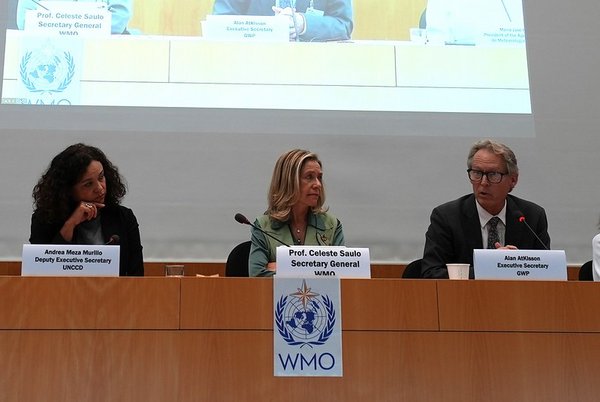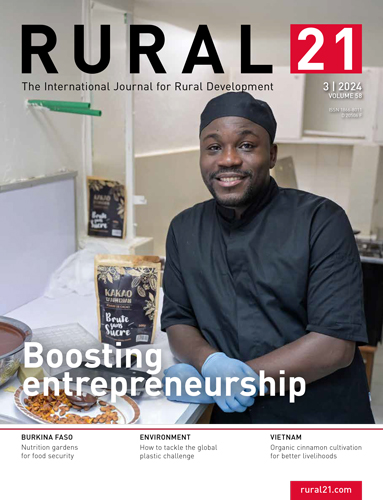Andrea Meza Murillo, Deputy Executive Secretary of the United Nations Convention to Combat Desertification (UNCCD), Celeste Saulo, Secretary-General of the World Meteorological Organization (WMO) and Alan AtKisson, Secretary, Global Water Partnership (GWP) on the Drought Resilience +10 Conference.
Photo: WMO
 Read this article in French
Read this article in French- Share this article
- Subscribe to our newsletter
Drought Resilience Conference calls for accelerated action
Droughts are becoming more intense and frequent due to changes in the hydrological cycle. Recognising the urgency of this challenge, nearly 1,000 experts, policymakers, and practitioners participated in the Drought Resilience +10 Conference, hosted by the World Meteorological Organization (WMO), from the 30th September - 2nd October 2024 in Geneva, Switzerland.
2023 marked the driest year for global rivers and streamflow levels in more than three decades of record-keeping on record — an alarming signal of critical changes in water availability.
The Conference aimed to:
- reflect on the successes and challenges in drought risk management over the past decade, following the 2013 High-Level Meeting on National Drought Policy, and discuss how to achieve drought resilience in the coming years
- plan how to scale up drought resilience efforts to respond to the accelerating impacts of climate change
- engage decision-makers to raise awareness, mobilise resources, and prioritise resilience through integrated drought management strategies
- “We hope that the alignment between the technical findings and policy direction will strengthen political will and set the course for integrated drought management in the coming years, ensuring that both immediate and long-term actions are prioritised in global and regional agendas,” said WMO Secretary-General Celeste Saulo.
Outcomes and Recommendations
Discussions focused on nine key themes, each addressing key aspects of drought management and reflecting the central challenges and opportunities for building drought resilience globally.
A number of key recommendations were issued to guide global drought policy and action over the next decade. These include:
- Drought Resilience and Global Alignment: There is a need to strengthen international collaboration on drought risks and align efforts across frameworks like the Paris Agreement, Sendai Framework and Sustainable Development Goals (SDGs).
- Drought Risk Governance: Drought risk management needs to shift towards an integrated systems approach, embedding Sustainable Land Management and Integrated Water Resources Management into national and regional drought policies.
- Drought Monitoring, Impact Assessments and Forecasting: There is a need for better monitoring, prediction and systematic collection of impact data, including for cascading and compounding impacts, as well as fast-moving flash droughts, to address key challenges
- From policies to action: All stakeholders are encouraged to mobilise resources, catalyse political will and operationalise national drought plans which follow the principles of proactive, prospective and integrated drought management at national, regional, and global levels.
- Ecosystems: Drought resilience strategies should prioritise ecosystems, focusing on water quality, groundwater management and the protection of aquatic habitats.
- Social Inclusion and Climate Justice: Drought disproportionately affects marginalised groups, including women, youth, Indigenous Peoples and communities in remote and rural areas. The conference called for intersectoral, gender-transformative and whole-of-society approaches to be integrated into national drought policies.
- Drought Finance: Stakeholders and private entities are encouraged to increase financial flows to drought resilience projects. Emphasis was put on innovative financing mechanisms, including private sector engagement and youth-friendly funding.
- Public-private-civil society partnerships: Stakeholders should be open to new approaches to foster innovative partnerships.
- Health: Help public health systems prepare for drought-associated health risks by enhancing understanding of how drought impacts environmental, economic and social determinants of health, as well as directly or indirectly affecting on human health.
Key Takeaways
The following points were particularly stressed during the discussions:
- We need integrated, proactive and perspective drought management to cope with drought.
- Cross-sectoral and whole-of-society approaches must be integrated into national drought policies.
- Strengthening data-sharing and monitoring systems is crucial.
- Drought action is central to sustainable development, climate adaptation and Early Warnings for All.
- There is a critical need to mobilise resources and strengthen political will for drought resilience.
In the following years, the Integrated Drought Management Programme (IDMP) and the International Drought Resilience Alliance (IDRA) will play a key role in scaling up these efforts, with a focus on transboundary cooperation, public-private partnerships and the integration of drought resilience into global climate adaptation strategies.
The outcomes of the conference will inform the global drought community as well as the high-level discussions at UNCCD COP16 in December 2024, where drought resilience will be a central theme.
(WMO/ile)




Add a comment
Be the First to Comment